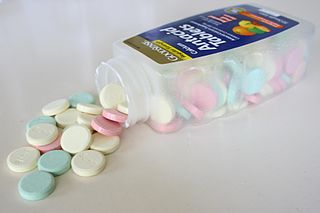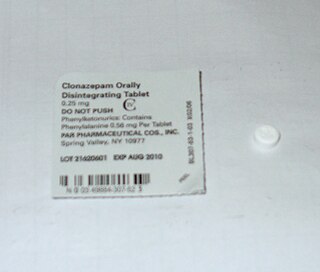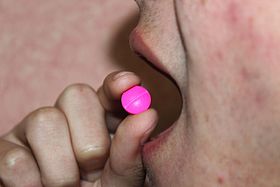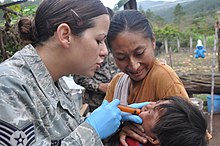
An antacid is a substance that neutralizes stomach acidity and is used to relieve heartburn, indigestion, or an upset stomach. Some antacids have been used in the treatment of constipation and diarrhea. Marketed antacids contain salts of aluminum, calcium, magnesium, or sodium. Some preparations contain a combination of two salts, such as magnesium carbonate and aluminum hydroxide.

A tablet is a pharmaceutical oral dosage form or solid unit dosage form. Tablets may be defined as the solid unit dosage form of medication with suitable excipients. It comprises a mixture of active substances and excipients, usually in powder form, that are pressed or compacted into a solid dose. The main advantages of tablets are that they ensure a consistent dose of medicine that is easy to consume.

In pharmacology and toxicology, a route of administration is the way by which a drug, fluid, poison, or other substance is taken into the body.

Benadryl is a brand of various antihistamine medications used to stop allergies, whose content varies in different countries, but which includes some combination of diphenhydramine, acrivastine, and/or cetirizine.
Ingestion is the consumption of a substance by an organism. In animals, it normally is accomplished by taking in a substance through the mouth into the gastrointestinal tract, such as through eating or drinking. In single-celled organisms, ingestion takes place by absorbing a substance through the cell membrane.
Excipient is a substance formulated alongside the active ingredient of a medication. Excipients serve various purposes, including long-term stabilization, bulking up solid formulations containing potent active ingredients in small amounts, or enhancing the therapeutic properties of the active ingredient in the final dosage form. They can facilitate drug absorption, reduce viscosity, or enhance solubility. Excipients can also aid in the manufacturing process by improving the handling of active substances, facilitating powder flowability, or preventing denaturation and aggregation during the expected shelf life. The selection of excipients depends on factors such as the route of administration, dosage form, and active ingredient.
Benzonatate, sold under the brand name Tessalon among others, is a medication that is used for the symptomatic relief of cough. A 2023 systematic review found that there is inadequate evidence to support the effectiveness and safety of benzonatate for cough and highlighted rising safety concerns. Benzonatate is taken by mouth. Effects generally begin within 20 minutes and last 3 to 8 hours.
An enteric coating is a polymer barrier applied to oral medication that prevents its dissolution or disintegration in the gastric environment. This helps by either protecting drugs from the acidity of the stomach, the stomach from the detrimental effects of the drug, or to release the drug after the stomach. Some drugs are unstable at the pH of gastric acid and need to be protected from degradation. Enteric coating is also an effective method to obtain drug targeting. Other drugs such as some anthelmintics may need to reach a high concentration in a specific part of the intestine. Enteric coating may also be used during studies as a research tool to determine drug absorption. Enteric-coated medications pertain to the "delayed action" dosage form category. Tablets, mini-tablets, pellets and granules are the most common enteric-coated dosage forms.
Sublingual, from the Latin for "under the tongue", refers to the pharmacological route of administration by which substances diffuse into the blood through tissues under the tongue.
Absorption is the journey of a drug travelling from the site of administration to the site of action.

Drug injection is a method of introducing a drug into the bloodstream via a hollow hypodermic needle, which is pierced through the skin into the body. Intravenous therapy, a form of drug injection, is universally practiced in modernized medical care. As of 2004, there were 13.2 million people worldwide who self-administered injection drugs outside of medical supervision, of which 22% are from developed countries.
Dosage forms are pharmaceutical drug products in the form in which they are marketed for use, with a specific mixture of active ingredients and inactive components (excipients), in a particular configuration, and apportioned into a particular dose. For example, two products may both be amoxicillin, but one is in 500 mg capsules and another is in 250 mg chewable tablets. The term unit dose can also sometimes encompass non-reusable packaging as well, although the FDA distinguishes that by unit-dose "packaging" or "dispensing". Depending on the context, multi(ple) unit dose can refer to distinct drug products packaged together, or to a single drug product containing multiple drugs and/or doses. The term dosage form can also sometimes refer only to the pharmaceutical formulation of a drug product's constituent drug substance(s) and any blends involved, without considering matters beyond that. Because of the somewhat vague boundaries and unclear overlap of these terms and certain variants and qualifiers within the pharmaceutical industry, caution is often advisable when conversing with someone who may be unfamiliar with another person's use of the term.

An orally disintegrating tablet or orally dissolving tablet (ODT) is a drug dosage form available for a limited range of over-the-counter (OTC) and prescription medications. ODTs differ from traditional tablets in that they are designed to be dissolved on the tongue rather than swallowed whole. The ODT serves as an alternative dosage form for patients who experience dysphagia or for where compliance is a known issue and therefore an easier dosage form to take ensures that medication is taken. Common among all age groups, dysphagia is observed in about 35% of the general population, as well as up to 60% of the elderly institutionalized population and 18-22% of all patients in long-term care facilities ODTs may have a faster onset of effect than tablets or capsules, and have the convenience of a tablet that can be taken without water. During the last decade, ODTs have become available in a variety of therapeutic markets, both OTC and by prescription.
Pharmaceutical formulation, in pharmaceutics, is the process in which different chemical substances, including the active drug, are combined to produce a final medicinal product. The word formulation is often used in a way that includes dosage form.
Modified-release dosage is a mechanism that delivers a drug with a delay after its administration or for a prolonged period of time or to a specific target in the body.

Thin-film drug delivery uses a dissolving film or oral drug strip to administer drugs via absorption in the mouth and/or via the small intestines (enterically). A film is prepared using hydrophilic polymers that rapidly dissolves on the tongue or buccal cavity, delivering the drug to the systemic circulation via dissolution when contact with liquid is made.

Rectal administration uses the rectum as a route of administration for medication and other fluids, which are absorbed by the rectum's blood vessels, and flow into the body's circulatory system, which distributes the drug to the body's organs and bodily systems.

The Poison Prevention Packaging Act of 1970 (PPPA); was signed into law by U.S. President Richard Nixon on December 30, 1970. It was enacted by the 91st United States Congress. This law required the use of child-resistant packaging for prescription drugs, over-the-counter (OTC) drugs, household chemicals, and other hazardous materials that could be considered dangerous for children.
Buccal administration is a topical route of administration by which drugs held or applied in the buccal area diffuse through the oral mucosa and enter directly into the bloodstream. Buccal administration may provide better bioavailability of some drugs and a more rapid onset of action compared to oral administration because the medication does not pass through the digestive system and thereby avoids first pass metabolism. Drug forms for buccal administration include tablets and thin films.
A digital pill is a pharmaceutical dosage form that contains an ingestible sensor inside of a pill. The sensor begins transmitting medical data after it is consumed. The technology that makes up the pill, as well as the data transmitted by the pill's sensor, are considered to be part of digital medicine. The purpose of the sensor is to determine whether the person is taking their medication or not. There are privacy concerns with respect to who receives the data and what is done with it. Such privacy concerns, along with uncertain economic benefits, have made the broad introduction of digital pills in the healthcare practice challenging, despite accumulating body of clinical evidence indicating their efficacy and safety.

















